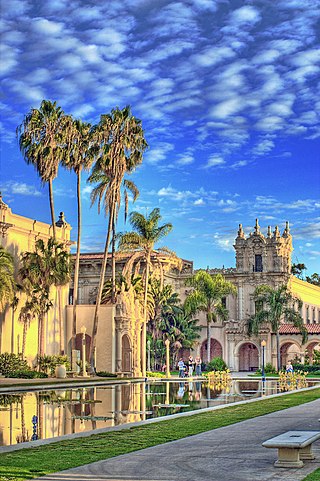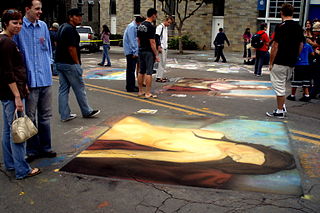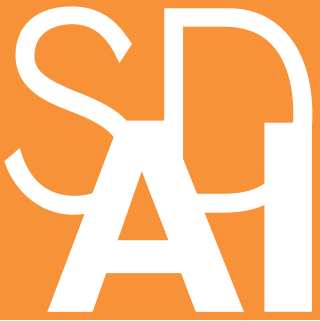
The Panama–California Exposition was a world exposition held in San Diego, California, between January 1, 1915, and January 1, 1917. The exposition celebrated the opening of the Panama Canal, and was meant to tout San Diego as the first United States port of call for ships traveling north after passing westward through the canal. The fair was held in San Diego's large urban Balboa Park. The park held a second Panama-California exposition in 1935.

The Fleet Science Center is a science museum and planetarium in Balboa Park in San Diego, California. Established in 1973, it was the first science museum to combine interactive science exhibits with a planetarium and an IMAX Dome (OMNIMAX) theater, setting the standard that most major science museums follow today. It is located at the east end of the El Prado Drive walkway, next to the Bea Evenson Fountain and plaza in central Balboa Park.

Barrio Logan is a neighborhood in south central San Diego, California. It is bordered by the neighborhoods of East Village and Logan Heights to the north, Shelltown and Southcrest to the east, San Diego Bay to the southwest, and National City to the southeast. Interstate 5 forms the northeastern boundary. The Barrio Logan Community Plan Area comprises approximately 1,000 acres, of which slightly more than half is under the jurisdiction of the Port of San Diego or the United States Navy rather than the city of San Diego. The community is subject to the California Coastal Act. Though located near the city's central core, it has long been considered part of Southeast San Diego by many locals, being directly southeast of downtown San Diego, and with previous historical records labeling it as part of "Western Southeast San Diego."

The Centro Cultural de la Raza is a non-profit organization with the specific mission to create, preserve, promote and educate about Chicano, Mexicano, Native American and Latino art and culture. It is located in Balboa Park in San Diego, California. The cultural center supports and encourages the creative expression “of the indigenous cultures of the Americas.” It is currently a member of the American Alliance of Museums.

The California Pacific International Exposition was an exposition held in San Diego, California, during May 29, 1935–November 11, 1935 and February 12, 1936–September 9, 1936. The exposition was held in Balboa Park, San Diego's large central urban park, which had also been the site of the earlier Panama–California Exposition in 1915.

University Heights is a neighborhood in San Diego, California, centered on Park Boulevard and Adams Avenue. University Heights is bounded on the west and north by the edge of the mesa, the southern boundary is Lincoln Avenue, and the eastern boundary is Texas Street. The area is filled with a number of restaurants, coffee shops, boutiques, and artist studios primarily on Park Boulevard and Adams Avenue. Live entertainment can be found most nights. Adjacent to Hillcrest, Normal Heights and North Park, additional restaurants, bars, coffee shops, and night clubs are within easy reach.

TheSan Diego Museum of Art is a fine art museum in Balboa Park in San Diego, California, that houses a broad collection with particular strength in Spanish art. It opened as the Fine Arts Gallery of San Diego on February 28, 1926, and changed to its current name in 1978. The official Balboa Park website calls it "the region's oldest and largest art museum". Nearly half a million people visit the museum each year.

The Spreckels Organ Pavilion is an outdoor venue that houses the open-air Spreckels Organ in Balboa Park in San Diego, California. With more than 5,000 pipes, the Spreckels Organ is the world's largest pipe organ in a fully outdoor venue. Constructed for the 1915 Panama–California Exposition, it is located at the corner of President's Way and Pan American Road East in the park.

Downtown San Diego is the central business district of San Diego, California, the eighth largest city in the United States. It houses the major local headquarters of the city, county, state, and federal governments. The area comprises seven districts: Gaslamp Quarter, East Village, Columbia, Marina, Cortez Hill, Little Italy, and Core.

The culture of San Diego is influenced heavily by American and Mexican cultures due to its position as a border town, its large Hispanic population, and its history as part of Spanish America and Mexico. San Diego's longtime association with the U.S. military also contributes to its culture. Present-day culture includes many historical and tourist attractions, a thriving musical and theatrical scene, numerous notable special events, a varied cuisine, and a reputation as one of America's premier centers of craft brewing.

The Ford Building is a Streamline Moderne structure in Balboa Park in San Diego, California, that serves as the home of the San Diego Air & Space Museum. The building was built by the Ford Motor Company for the California Pacific International Exposition, which was held in 1935 and 1936. The Ford Motor Company built a total of five exposition buildings for the world's fairs. This is the last remaining structure.

Balboa Theatre is a historic movie and vaudeville theatre in downtown San Diego, California, United States. It was built in 1924. Listed on the National Register of Historic Places in 1996, Balboa Theatre was refurbished and reopened as a performing arts venue in 2008.

The San Diego Art Institute was a contemporary art museum with a focus on artists from the Southern California and Baja Norte region. It was founded in 1941 as the San Diego Business Men's Art Club. Its name was changed in 1950 to the San Diego Art Institute. In 1953, women were admitted for membership. It officially became a nonprofit in 1963. The San Diego Art Institute in Balboa Park and Lux Art Institute in Encinitas merged in September 2021 to become the Institute of Contemporary Art, San Diego, with each museum continuing to operate at its respective site.

The House of Charm is a historic museum building in Balboa Park in San Diego, California. It was built for the 1915–16 Panama–California Exposition, and like most buildings from the exposition, it features Mission Revival architecture. It acquired its current name during the California Pacific International Exposition. It now houses the Mingei International Museum as well as rehearsal space for the Old Globe Theatre. It is listed on the National Register of Historic Places.

Balboa Park is a 1,200-acre (490 ha) historic urban cultural park in San Diego, California. Placed in reserve in 1835, the park's site is one of the oldest in the United States dedicated to public recreational use. The park hosts various museums, theaters, restaurants, and the San Diego Zoo. It is managed and maintained by the Parks and Recreation Department of the City of San Diego.

The California Quadrangle, California Building, and California Tower are historic structures located in Balboa Park in San Diego, California. They were built for the 1915–16 Panama–California Exposition and served as the grand entry to the event. The buildings and courtyard were designed by architect Bertram Goodhue. They were added to the National Register of Historic Places on May 17, 1974. They now house the Museum of Us.

El Prado Complex is a historic district in Balboa Park in San Diego, California. The 13-acre (5.3 ha) complex includes 13 contributing buildings and one contributing structure. Most of the structures were built for San Diego's Panama–California Exposition of 1915–16 and were refurbished and re-used for the California Pacific International Exposition of 1935–36. The original architects were Bertram Goodhue and Carleton Winslow. The area was listed on the National Register of Historic Places in 1976.
Guillermo Acevedo (1920–1988) was a Peruvian-born artist and master draftsman, most famous in the United States for his striking portrayal of Native Americans of the Southwest, and for his ability to capture and help preserve the disappearing architectural styles of old neighborhoods throughout the U.S. and abroad. Known to be an artist-observer with great sensitivity, Acevedo is recognized as a master at recording the human condition.
Anni von Westrum Baldaugh was an American painter of Dutch birth.
Hispanic and Latino Americans make up 30.1% of the population of San Diego, California, and 35.0% of San Diego County, with the majority of Hispanics and Latinos in San Diego being Mexican American.

















